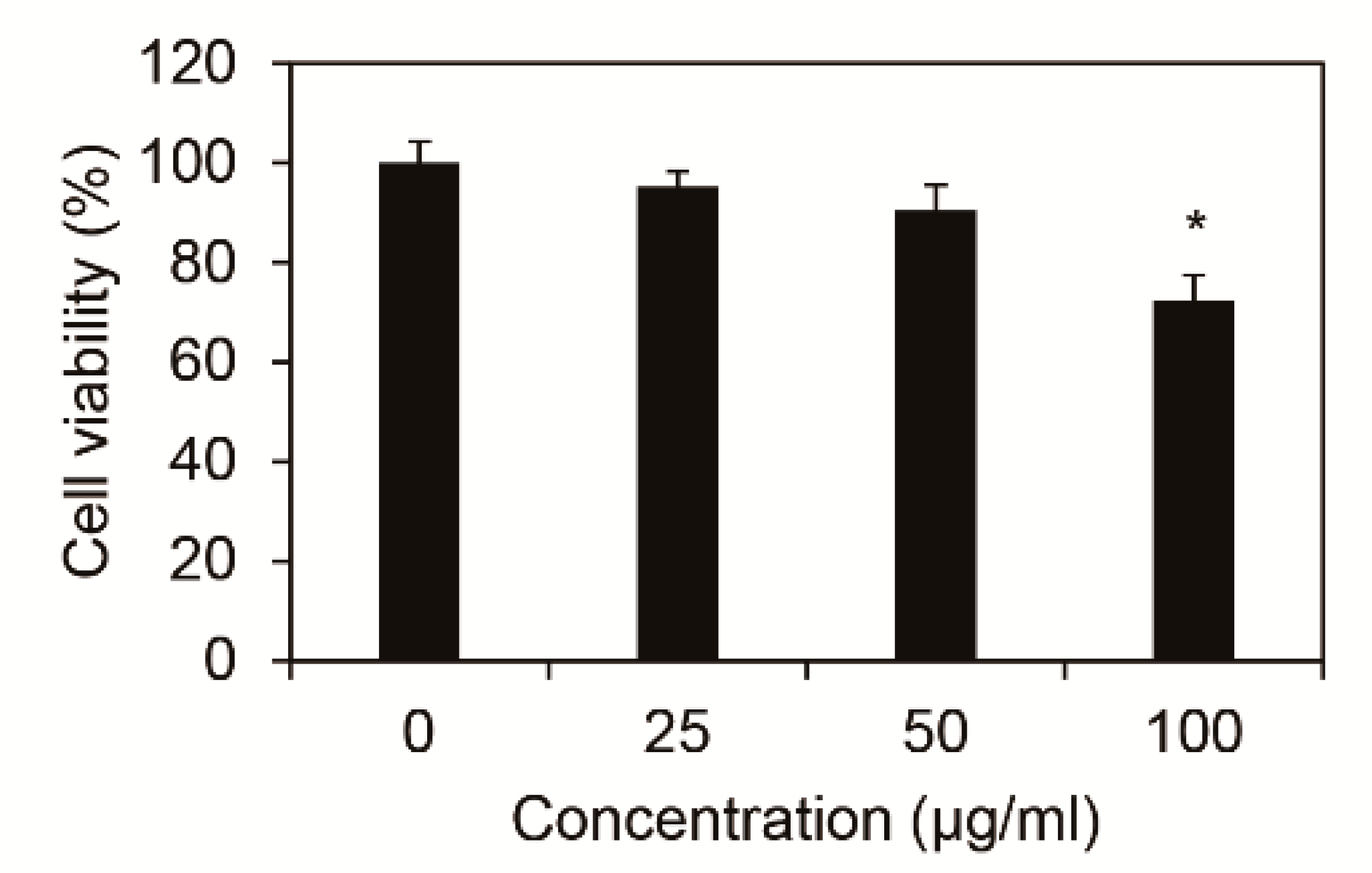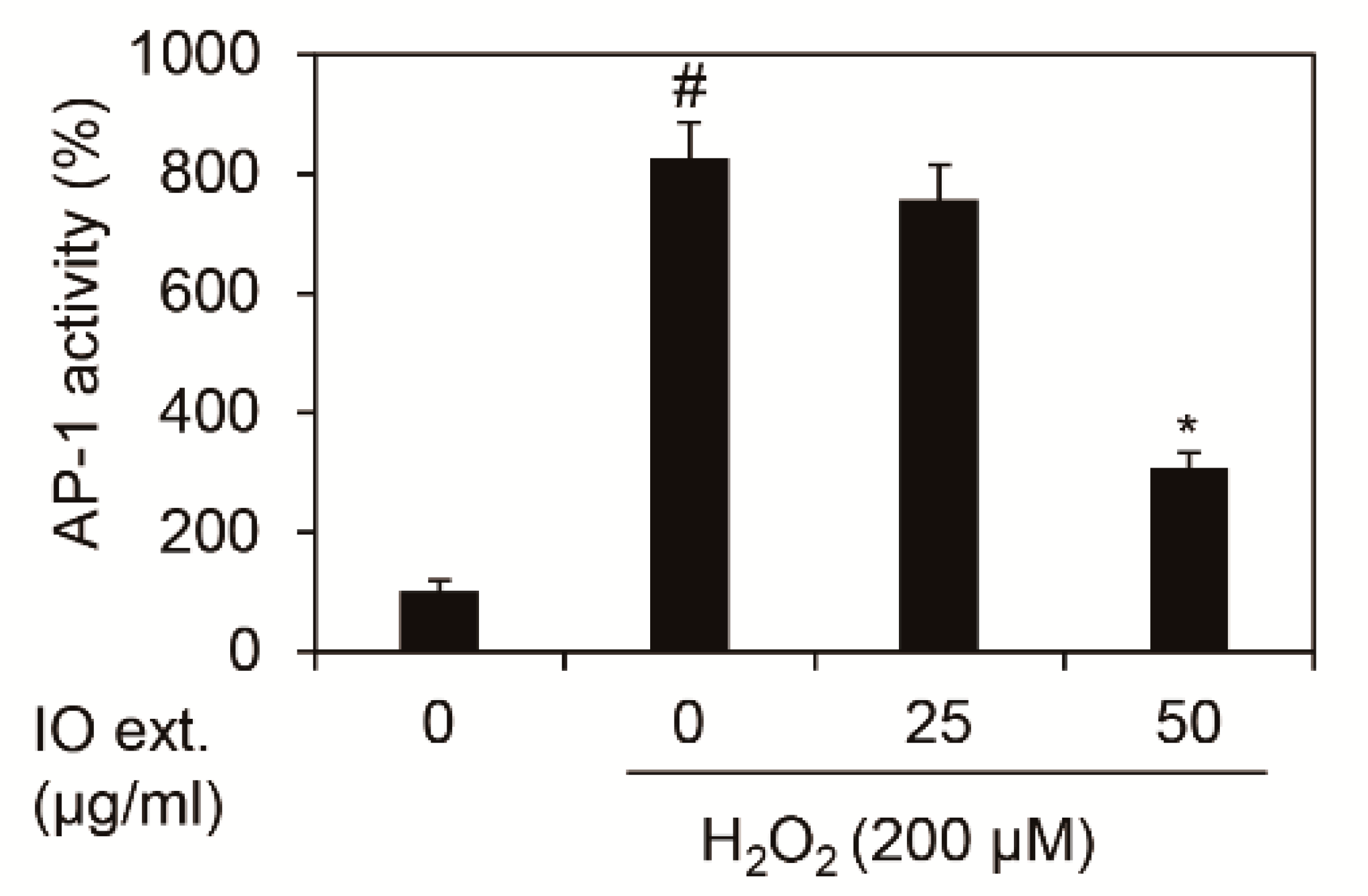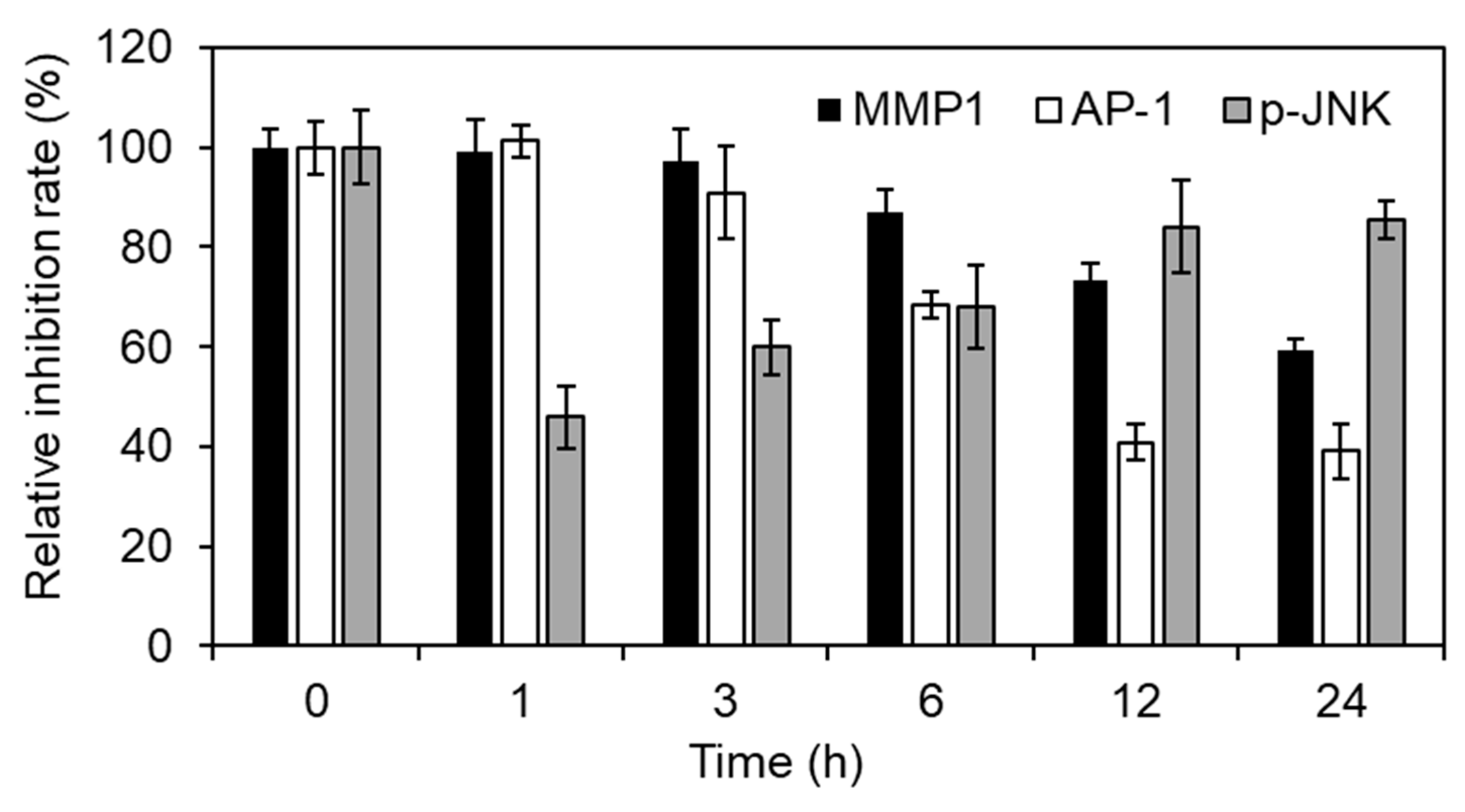Inonotus obliquus Extracts Decreased Expression of MMP1 mRNA via JNK-AP-1 Axis
Abstract
1. Introduction
2. Materials and Methods
2.1. Cell Culture
2.2. Preparation of Inonotus obliquus Extracts
2.3. Cell Viability Assay
2.4. Quantitative Real Ttime Polymerase Chain Reaction (qRT-PCR)
2.5. Western Blot
2.6. Luciferase Assay
2.7. Statistical Analysis
3. Results
3.1. Cytotoxicity Measurement of Inonotus obliquus Extracts in nHDFs
3.2. MMP1 mRNA Expression Suppression of Inonotus obliquus Extracts in nHDFs
3.3. AP-1 Transcriptional Activity Suppression of Inonotus obliquus Extracts in nHDFs
3.4. JNK Phosphorylation Suppression of Inonotus obliquus Extracts in nHDFs
3.5. JNK-AP-1 Axis Mediated MMP1 mRNA Regulation of Inonotus obliquus Extracts in nHDFs
4. Discussion
5. Conclusions
Author Contributions
Funding
Conflicts of Interest
References
- Quan, T.; Qin, Z.; Xia, W.; Shao, Y.; Voorhees, J.J.; Fisher, G.J. Matrix-degrading metalloproteinases in photoaging. J. Investig. Dermatol. Symp. Proc. 2009, 14, 20–24. [Google Scholar] [CrossRef] [PubMed]
- Shin, J.W.; Kwon, S.H.; Choi, J.Y.; Na, J.I.; Huh, C.H.; Choi, H.R.; Park, K.C. Molecular Mechanisms of Dermal Aging and Antiaging Approaches. Int. J. Mol. Sci. 2019, 20, E2126. [Google Scholar] [CrossRef] [PubMed]
- Fisher, G.J.; Kang, S.; Varani, J.; Bata-Csorgo, Z.; Wan, Y.; Datta, S.; Voorhees, J.J. Mechanisms of Photoaging and Chronological Skin Aging. Arch. Dermatol. 2002, 138, 1462–1470. [Google Scholar] [CrossRef] [PubMed]
- Bateman, J.F.; Lamandé, S.R.; Ramshaw, J.A.M. Collagen superfamily. In Extracellular Matrix; Comper, W.D., Ed.; Harwood Academic Publishers: Amsterdam, The Netherlands, 1996; pp. 22–67. [Google Scholar]
- Uitto, J. Connective tissue biochemistry of the aging dermis. Age-associated alterations in collagen and elastin. Dermatol. Clin. 1986, 4, 433–446. [Google Scholar] [CrossRef]
- Chung, H.Y.; Kim, H.J.; Shim, K.H.; Kim, K.W. Dietary modulation of prostanoid synthesis in the aging process: Role of cyclooxygenase-2. Mech. Aging Dev. 1999, 111, 97–106. [Google Scholar] [CrossRef]
- Coulomb, B.; Dubertet, L.; Merrill, C.; Touraine, R.; Bell, E. The collagen lattice: A model for studying the physiology, biosynthetic function and pharmacology of the skin. Br. J. Dermatol. 1984, 27, 83–87. [Google Scholar] [CrossRef] [PubMed]
- Fisher, G.J.; Voorhees, J.J. Molecular mechanisms of photoaging and its prevention by retinoic acid: Ultraviolet irradiation induces MAP kinase signal transduction cascades that induce AP-1-regulated matrix metalloproteinases that degrade human skin in vivo. J. Investig. Dermatol. Symp. Proc. 1998, 3, 61–68. [Google Scholar] [PubMed]
- Varani, J.; Spearman, D.; Perone, P.; Fligiel, S.E.G.; Datta, S.; Wang, Z.Q.; Voorhees, J.J. Inhibition of type I procollagen synthesis by damaged collagen in photoaged skin and by collagenase-degraded collagen in vitro. Am. J. Pathol. 2001, 158, 931–942. [Google Scholar] [CrossRef]
- Di, L.C.; Pei, Y.; Travers, J.B. Augmentation of ultraviolet B radiation-induced tumor necrosis factor production by the epidermal platelet-activating factor receptor. J. Biol. Chem. 1999, 274, 26917–26921. [Google Scholar]
- Angel, P.; Szabowski, A.; Schorpp-Kistner, M. Function and regulation of AP-1 subunits in skin physiology and pathology. Oncogene 2001, 20, 2413–2423. [Google Scholar] [CrossRef] [PubMed]
- Fisher, G.J.; Wang, Z.Q.; Datta, S.C.; Varani, J.; Kang, S.; Voorhees, J.J. Pathophysiology of premature skin aging induced by ultraviolet light. N. Engl. J. Med. 1997, 337, 1419–1428. [Google Scholar] [CrossRef] [PubMed]
- Dasgupta, J.; Kar, S.; Liu, R.; Joseph, J.; Kalyanaraman, B.; Remington, S.J.; Chen, C.; Melendez, J.A. Reactive oxygen species control senescence-associated matrix metalloproteinase-1 through c-Jun-N-terminal kinase. J. Cell. Physiol. 2010, 225, 52–62. [Google Scholar] [CrossRef] [PubMed]
- Risse, G.; Jooss, K.; Neuberg, M.; Brüller, H.J.; Müller, R. Asymmetrical recognition of the palindromic AP1 binding site (TRE) by Fos protein complexes. EMBO J. 1989, 8, 3825–3832. [Google Scholar] [CrossRef]
- Park, K.K.; Jung, E.; Chon, S.K.; Seo, M.; Kim, H.W.; Park, T. Finding of TRE (TPA responsive element) in the sequence of human taurine transporter promoter. Adv. Exp. Med. Biol. 2003, 526, 159–166. [Google Scholar] [PubMed]
- Leppä, S.; Saffrich, R.; Ansorge, W.; Bohmann, D. Differential regulation of c-Jun by ERK and JNK during PC12 cell differentiation. EMBO J. 1998, 17, 4404–4413. [Google Scholar] [CrossRef] [PubMed]
- Glamočlija, J.; Ćirić, A.; Nikolić, M.; Fernandes, Â.; Barros, L.; Calhelha, R.C.; Ferreira, I.C.; Soković, M.; van Griensven, L.J. Chemical characterization and biological activity of Chaga (Inonotus obliquus), a medicinal “mushroom”. J. Ethnopharmacol. 2015, 162, 323–332. [Google Scholar] [CrossRef] [PubMed]
- Taofiq, O.; Heleno, S.A.; Calhelha, R.C.; Alves, M.J.; Barros, L.; Barreiro, M.F.; González-Paramás, A.M.; Ferreira, I.C. Development of Mushroom-Based Cosmeceutical Formulations with Anti-Inflammatory, Anti-Tyrosinase, Antioxidant, and Antibacterial Properties. Molecules 2016, 21, E1372. [Google Scholar] [CrossRef] [PubMed]
- Karin, M. The regulation of AP-1 activity by mitogenactivated protein kinases. J. Biol. Chem. 1995, 270, 16483–16486. [Google Scholar] [CrossRef]





© 2020 by the authors. Licensee MDPI, Basel, Switzerland. This article is an open access article distributed under the terms and conditions of the Creative Commons Attribution (CC BY) license (http://creativecommons.org/licenses/by/4.0/).
Share and Cite
Kim, Y.J.; Cha, H.J. Inonotus obliquus Extracts Decreased Expression of MMP1 mRNA via JNK-AP-1 Axis. Cosmetics 2020, 7, 36. https://doi.org/10.3390/cosmetics7020036
Kim YJ, Cha HJ. Inonotus obliquus Extracts Decreased Expression of MMP1 mRNA via JNK-AP-1 Axis. Cosmetics. 2020; 7(2):36. https://doi.org/10.3390/cosmetics7020036
Chicago/Turabian StyleKim, Young Joo, and Hwa Jun Cha. 2020. "Inonotus obliquus Extracts Decreased Expression of MMP1 mRNA via JNK-AP-1 Axis" Cosmetics 7, no. 2: 36. https://doi.org/10.3390/cosmetics7020036
APA StyleKim, Y. J., & Cha, H. J. (2020). Inonotus obliquus Extracts Decreased Expression of MMP1 mRNA via JNK-AP-1 Axis. Cosmetics, 7(2), 36. https://doi.org/10.3390/cosmetics7020036



